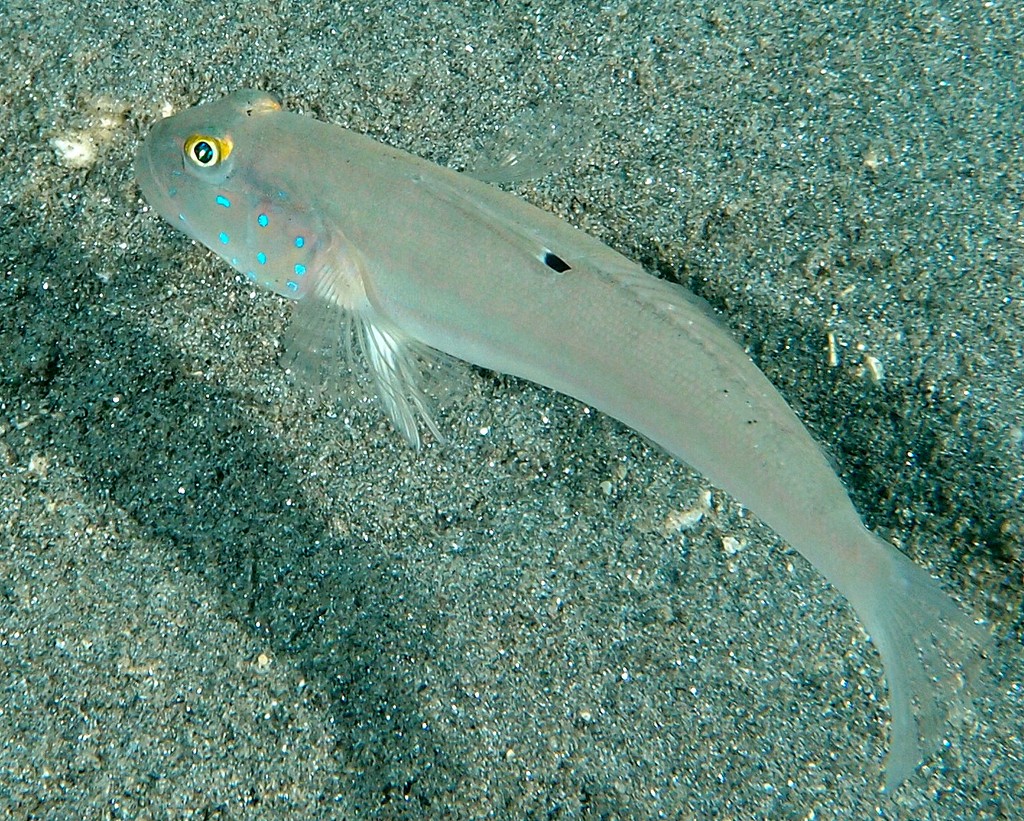VALENCIENNEA SEXGUTTATA - (VALENCIENNES, 1837)
Actinopterygii (Gigaclass) > Actinopteri (Class) > Teleostei (Subclass) > Gobiiformes (Order) > Gobioidei (Suborder) > Gobiidae (Family) > Gobiinae (Subfamily) > Valenciennea (Genus)
Gobie à six taches, Ladder glider, Ladder goby, Bluespotted glidergoby, Blacktip goby, Sixspot goby, Six-spot goby, Six-spot sleeper-goby, Sixspot glidergoby, Leer-swerwer, Sechspunkt-Schläfergrundel, Ghiozzo, Mizutamahaze, ミズタマハゼ, 六斑凡塘鱧, 六點塘鱧,
Synonymes
Eleotriodes pallidus (Klausewitz, 1960)
Eleotriodes sexguttatus (Valenciennes, 1837)
Eleotris lantzii (Thominot, 1878)
Eleotris sexguttata (Valenciennes, 1837)
Salarigobius stuhlmannii (Pfeffer, 1893)
Valencienea sexguttata (Valenciennes, 1837)
Valenciennea sexguttatus (Valenciennes, 1837)
Valenciennea violifera (Jordan & Seale, 1906)
-----------------------------
Description
Dorsal spines (total): 7; Second dorsal fin spine: 1; Dorsal soft rays: 12; Anal spine: 1; Anal soft rays: 11-13; Pectoral fin rays: 19-21; Lateral scale series: 71-99; Depth of body: 5.1-6.5 in SL. Transverse rows of scales backwards: 21-31; First dorsal fin pointed, absence of filamentous dorsal spines; Pointed caudal fin, longer in male: 2.9-3.6 in SL; Ctenoid body scales, becoming cycloid anterior to line from upper pectoral fin base to first dorsal fin origin and on abdomen; Head or midline of nape without scales; Side of nape with scales extending forward short distance anterior to gill opening; Partly or fully scaled prepelvic area. Pectoral fin bases naked or partly scaly. Max. length: 14.0 cm TL, 10.2 cm SL. Depth range: 3 - 25 m.
Color
Body sandy white to pale brown, with indistinct pink to reddish stripe along lower sides of body; Scattered blue
rounded spots on head; Distinct black spot between 3rd and 4th spines of 1st dorsal fin. Some color forms exist over its range.
Etymology
Valenciennea: in honnor of Achille Valenciennes (1794-1865) who was a French zoologist. He worked with Auguste Henri André Duméril (1812-1870), Georges Cuvier (1769-1832) and Bernard Germain de Lacépède (1756-1825) since 1815. He worked on the 22-volume of a "Histoire naturelle des poissons" (1828-1848), carrying on alone after Georges Cuvier died in 1832.
sexguttata: from Latin, sex = six + from Latin, guttātus = spotted, speckled. Referring to silver spots, consisting of two longitudinal rows of three spots each, on cheek and operculum.
Original description: Eleotris sexguttata Valenciennes, 1837- Type locality: Trincomalee, Sri Lanka.
Distribution
Red Sea; Indo-West Pacific: East Africa, Persian Gulf, Seychelles, Madagascar and Mascarenes (La Réunion, Mauritius, Rodrigues), east to Samoa and Tonga, north to Kagoshima Prefecture (southern Japan), south to Western Australia and Queensland (Australia) and New Caledonia.
Biology
Inhabits silty or sandy areas of lagoons and bays. Usually in pairs and lives in a burrow under rocks. Commonly seen in aggregations over large areas in lagoons of atolls. Monogamous.
Last update: 14, April 2023
Gobie à six taches, Ladder glider, Ladder goby, Bluespotted glidergoby, Blacktip goby, Sixspot goby, Six-spot goby, Six-spot sleeper-goby, Sixspot glidergoby, Leer-swerwer, Sechspunkt-Schläfergrundel, Ghiozzo, Mizutamahaze, ミズタマハゼ, 六斑凡塘鱧, 六點塘鱧,
Synonymes
Eleotriodes pallidus (Klausewitz, 1960)
Eleotriodes sexguttatus (Valenciennes, 1837)
Eleotris lantzii (Thominot, 1878)
Eleotris sexguttata (Valenciennes, 1837)
Salarigobius stuhlmannii (Pfeffer, 1893)
Valencienea sexguttata (Valenciennes, 1837)
Valenciennea sexguttatus (Valenciennes, 1837)
Valenciennea violifera (Jordan & Seale, 1906)
-----------------------------
Description
Dorsal spines (total): 7; Second dorsal fin spine: 1; Dorsal soft rays: 12; Anal spine: 1; Anal soft rays: 11-13; Pectoral fin rays: 19-21; Lateral scale series: 71-99; Depth of body: 5.1-6.5 in SL. Transverse rows of scales backwards: 21-31; First dorsal fin pointed, absence of filamentous dorsal spines; Pointed caudal fin, longer in male: 2.9-3.6 in SL; Ctenoid body scales, becoming cycloid anterior to line from upper pectoral fin base to first dorsal fin origin and on abdomen; Head or midline of nape without scales; Side of nape with scales extending forward short distance anterior to gill opening; Partly or fully scaled prepelvic area. Pectoral fin bases naked or partly scaly. Max. length: 14.0 cm TL, 10.2 cm SL. Depth range: 3 - 25 m.
Color
Body sandy white to pale brown, with indistinct pink to reddish stripe along lower sides of body; Scattered blue
rounded spots on head; Distinct black spot between 3rd and 4th spines of 1st dorsal fin. Some color forms exist over its range.
Etymology
Valenciennea: in honnor of Achille Valenciennes (1794-1865) who was a French zoologist. He worked with Auguste Henri André Duméril (1812-1870), Georges Cuvier (1769-1832) and Bernard Germain de Lacépède (1756-1825) since 1815. He worked on the 22-volume of a "Histoire naturelle des poissons" (1828-1848), carrying on alone after Georges Cuvier died in 1832.
sexguttata: from Latin, sex = six + from Latin, guttātus = spotted, speckled. Referring to silver spots, consisting of two longitudinal rows of three spots each, on cheek and operculum.
Original description: Eleotris sexguttata Valenciennes, 1837- Type locality: Trincomalee, Sri Lanka.
Distribution
Red Sea; Indo-West Pacific: East Africa, Persian Gulf, Seychelles, Madagascar and Mascarenes (La Réunion, Mauritius, Rodrigues), east to Samoa and Tonga, north to Kagoshima Prefecture (southern Japan), south to Western Australia and Queensland (Australia) and New Caledonia.
Biology
Inhabits silty or sandy areas of lagoons and bays. Usually in pairs and lives in a burrow under rocks. Commonly seen in aggregations over large areas in lagoons of atolls. Monogamous.
Last update: 14, April 2023
